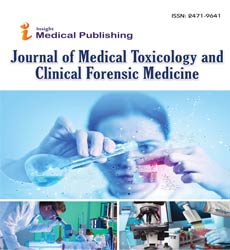Postmortem Toxicology in Suspected Drug Overdose Cases: Advances in Analytical Techniques
Katrin Vogel
Department of Forensic Medicine, University of Zurich, Zurich, Switzerland
Published Date: 2025-02-28DOI10.36648/ 2471-641.11.1.158
Received date: February 03, 2025, Manuscript No. ipjmtcm-25-20807; Editor assigned date: February 05, 2025, Pre QC No. ipjmtcm-25-20807 (PQ); Reviewed date: February 17, 2025, QC No. ipjmtcm-25-20807; Revised date: February 22, 2025, Manuscript No. ipjmtcm-25-20807 (R); Published date: February 28, 2025, DOI: 10.36648/ 2471-641.11.1.158.
Citation: Vogel K (2025) Postmortem Toxicology in Suspected Drug Overdose Cases: Advances in Analytical Techniques. J Med Toxicol Clin Forensic: Vol.11 No. 1:158.
Introduction
Drug overdose remains one of the leading causes of preventable mortality worldwide, with opioids, benzodiazepines, stimulants, and novel psychoactive substances frequently implicated. In medico-legal practice, establishing whether drugs contributed to or directly caused death is crucial for determining the manner and cause of death. Postmortem toxicology, the scientific analysis of biological specimens after death, plays a central role in such investigations. With rapid advancements in analytical chemistry, forensic toxicologists are now better equipped to detect, quantify, and interpret a wide range of substances. This article explores the evolving role of postmortem toxicology in suspected drug overdose cases, focusing on the analytical breakthroughs that enhance accuracy and reliability. The primary objective of postmortem toxicology is to identify toxic agents, determine their concentrations, and correlate findings with autopsy and circumstantial evidence. In suspected overdose cases, toxicology provides insight into whether death resulted from therapeutic drug use, accidental overconsumption, or intentional self-poisoning. Importantly, toxicology does not function in isolation but is interpreted in conjunction with autopsy findings, histopathology, and investigative reports [1].
Description
Interpreting toxicological results in postmortem cases is complicated by several factors. Postmortem redistribution, where drug concentrations shift between central and peripheral compartments after death, can result in misleading values. The stability of drugs in different matrices is also variable, with some compounds rapidly degrading or metabolizing postmortem. Furthermore, poly-drug overdoses, increasingly common in modern forensic casework, complicate the establishment of causal relationships. These challenges necessitate the use of advanced analytical techniques that can differentiate parent drugs from metabolites and account for matrix effects [2].
A wide variety of specimens can be analyzed in postmortem toxicology, including blood, urine, vitreous humor, liver, kidney, brain, and hair. Peripheral blood, such as femoral or subclavian samples, is preferred for quantitative analysis due to reduced redistribution effects compared to central blood. Vitreous humor provides stability for electrolyte and ethanol analysis, while hair testing can reveal long-term patterns of drug exposure. Tissue analysis, particularly of the liver, may be essential when blood samples are unavailable or degraded. Advances in micro-sampling techniques now allow for accurate analysis even in cases with limited or decomposed specimens [3].
GC-MS has long been considered the gold standard in forensic toxicology. It offers high specificity and sensitivity, particularly for volatile and semi-volatile compounds such as amphetamines, barbiturates, and cannabinoids. The ability to generate unique mass spectral fingerprints makes GC-MS invaluable for confirmatory testing. However, it often requires derivatization for thermally unstable compounds and may not be suitable for highly polar drugs. Despite these limitations, GC-MS remains a cornerstone in postmortem toxicology [4].
LC-MS/MS has revolutionized toxicological analysis by enabling the detection of a broader range of drugs, including thermally labile and polar compounds. It provides superior sensitivity, allowing detection of substances at trace levels, which is especially important in cases involving potent synthetic opioids such as fentanyl analogues. Its ability to simultaneously screen for multiple drugs in complex biological matrices makes it highly efficient. The ongoing development of high-resolution LC-MS platforms further enhances the ability to identify novel psychoactive substances and previously undetectable compounds. HRMS represents one of the most significant advancements in modern forensic toxicology. Unlike targeted methods, HRMS allows for non-targeted screening, enabling the retrospective identification of emerging substances without prior reference standards [5].
Conclusion
Postmortem toxicology is indispensable in investigating suspected drug overdose cases, providing vital evidence for forensic and legal determinations. The advent of advanced analytical techniques-particularly LC-MS/MS and HRMS-has dramatically enhanced the sensitivity, specificity, and scope of toxicological profiling. These innovations allow for more reliable detection of conventional drugs, novel psychoactive substances, and ultra-potent synthetic opioids. Nonetheless, analytical sophistication must be paired with careful interpretation, awareness of postmortem changes, and integration with autopsy findings. As drug trends evolve and forensic demands grow, continued advancement in toxicological techniques will be crucial to ensuring justice, public health, and scientific integrity.
Acknowledgement
None.
Conflict of Interest
None.
References
- Rzepczyk S, Dolià ?ska-Kaczmarek K, Uruska A, à »aba, C. (2022). The other face of insulin—overdose and its effects. Toxics10: 123.
Google Scholar Cross Ref Indexed at
- Labay LM, Bitting CP, Legg KM, Logan BK. (2016). The determination of insulin overdose in postmortem investigations. Academic Forensic Pathology6: 174-183.
Google Scholar Cross Ref Indexed at
- Legg KM, Labay LM, Aiken SS, Logan BK. (2019). Validation of a fully automated immunoaffinity workflow for the detection and quantification of insulin analogs by LC–MS-MS in postmortem vitreous humor. J Anal Toxicol43: 505-511.
Google Scholar Cross Ref Indexed at
- Heurtault B, Reix N, Meyer N, Gasser F, Wendling MJ, et al. (2014). Extensive study of human insulin immunoassays: Promises and pitfalls for insulin analogue detection and quantification. Clin Chem Lab Med52: 355-362.
Google Scholar Cross Ref Indexed at
- Owen WE, Roberts WL. (2004). Cross-reactivity of three recombinant insulin analogs with five commercial insulin immunoassays. Clin Chem50: 257-259.

Open Access Journals
- Aquaculture & Veterinary Science
- Chemistry & Chemical Sciences
- Clinical Sciences
- Engineering
- General Science
- Genetics & Molecular Biology
- Health Care & Nursing
- Immunology & Microbiology
- Materials Science
- Mathematics & Physics
- Medical Sciences
- Neurology & Psychiatry
- Oncology & Cancer Science
- Pharmaceutical Sciences
